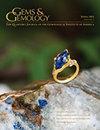HPHT合成金刚石光学缺陷的光致发光映射
IF 1.6
3区 地球科学
Q2 MINERALOGY
引用次数: 3
摘要
也称为点缺陷,吸收可见光产生颜色(Collins,1982)。通过这种方式,光学中心在贸易中产生了各种各样的彩色钻石。由于金刚石中的杂质(如氮或硼)、晶格变形、碳原子(空位)缺失或这些因素的组合,可能会形成光学中心(Collins,2003;Breeding和Shigley,2009)。当光学中心通过光子的吸收被激发到更高的能量状态,然后返回到其基态,发射特定波长或波段的光时,就会发生光致发光(Collins,1992;Eaton Magaña和Breeding,2016)。目前,金刚石中有数百个已知的光学中心产生光致发光(例如,Collins,1999;Zaitsev,2001)。光致发光(PL)光谱法是宝石学实验室中使用的一种强大工具,用于验证标本是天然的还是合成的,并确定其颜色来源是自然的还是经过处理的(Eaton Magaña and Breeding,2016)。一个缺点是本文章由计算机程序翻译,如有差异,请以英文原文为准。
Photoluminescence Mapping of Optical Defects in HPHT Synthetic Diamond
oknown as point defects, absorb visible light to produce color (Collins, 1982). In this way, optical centers give rise to the variety of fancy-color diamonds available in the trade. Optical centers can form as a result of impurities in the diamond (such as nitrogen or boron), deformation of the crystal lattice, missing carbon atoms (vacancies), or a combination of these (Collins, 2003; Breeding and Shigley, 2009). Photoluminescence occurs when an optical center is excited to a higher energy state by the absorption of photons and then returns to its ground energy state, emitting light at a specific wavelength or band of wavelengths (Collins, 1992; Eaton-Magaña and Breeding, 2016). There are currently several hundred known optical centers in diamond that produce photoluminescence (e.g., Collins, 1999; Zaitsev, 2001). Photoluminescence (PL) spectroscopy is a powerful tool used in gemological laboratories to verify whether a specimen is natural or synthetic and determine whether its color origin is natural or due to treatment (Eaton-Magaña and Breeding, 2016). One drawback is
求助全文
通过发布文献求助,成功后即可免费获取论文全文。
去求助
来源期刊

Gems & Gemology
地学-矿物学
CiteScore
2.90
自引率
19.20%
发文量
10
期刊介绍:
G&G publishes original articles on gem materials and research in gemology and related fields. Manuscript topics include, but are not limited to:
Laboratory or field research;
Comprehensive reviews of important topics in the field;
Synthetics, imitations, and treatments;
Trade issues;
Recent discoveries or developments in gemology and related fields (e.g., new instruments or identification techniques, gem minerals for the collector, and lapidary techniques);
Descriptions of notable gem materials and localities;
Jewelry manufacturing arts, historical jewelry, and museum exhibits.
 求助内容:
求助内容: 应助结果提醒方式:
应助结果提醒方式:


